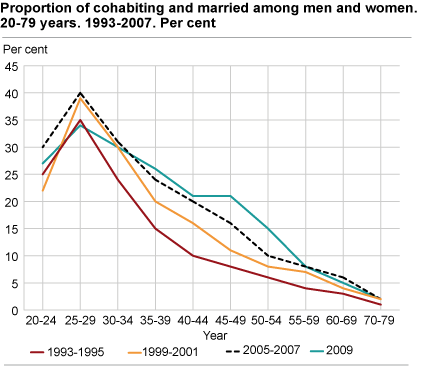Content
Published:
This is an archived release.
Stable proportion of cohabitants
The proportion of cohabitants makes up 25 per cent of all those in a live-in relationship, as has been the case in recent years. Cohabitation is still most widespread among young persons.
In the period 1993-95, 20 per cent of those living in a relationship were cohabitants. This proportion rose steadily until 2002-04, and has thereafter been 25 per cent. The term in a live-in relationship refers to a person who was cohabiting or married at the time of the interview. In total, 34 per cent of the respondents answered they do not live in a relationship. This is a small increase since 2008.
Cohabiting is still most widespread among persons in their 20s and 30s. The highest proportion of cohabitants, among all the respondents, was among women between 25-29 years of age, with 39 per cent. The highest proportion among men was also in the same age group, with 39 per cent. In 2008, the proportions were 44 and 37 per cent respectively.
According to interview data, the total number of cohabitants is estimated at about 300 000 couples. This is a higher estimate than figures based on registers, where it is 510 000 cohabitants. Stricter requirements with regard to legal residence address imply that cohabitants must have the same residence address in order to be classified as cohabitants in the register based statistics, as opposed to interview surveys.
Tables:
Contact
-
Ane Margrete Tømmerås
E-mail: ane.tommeras@ssb.no
tel.: (+47) 91 99 29 62
-
Anders Sønstebø
E-mail: anders.sonstebo@ssb.no
tel.: (+47) 46 66 37 74
-
Statistics Norway's Information Centre
E-mail: informasjon@ssb.no
tel.: (+47) 21 09 46 42

